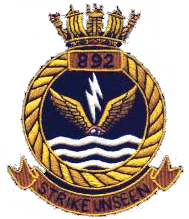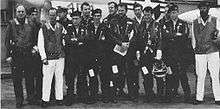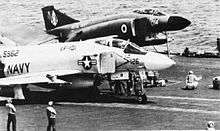892 Naval Air Squadron
892 Naval Air Squadron (892 NAS) was a carrier-based fighter squadron of the British Royal Navy's Fleet Air Arm. It was formed in 1943, flying Grumman Martlets, and was the only operational Fleet Air Arm squadron to fly the McDonnell Douglas Phantom FG.1.
| 892 Naval Air Squadron | |
|---|---|
 Badge of 892 NAS | |
| Active | 1942-1943 1945-1968 1969-1978 |
| Country | UK |
| Branch | Royal Navy, Fleet Air Arm |
| Type | Carrier based squadron |
| Role | fighter squadron |
| Station | RNAS Yeovilton, RAF Leuchars |
| Motto(s) | "Strike Unseen" |
History
892 Naval Air Squadron was first formed in July 1942 at Norfolk, Virginia, equipped with six Grumman Martlet IV fighters. It operated Martlets from escort aircraft carriers, flying from HMS Battler and HMS Archer,[1] disbanding in August 1943 when it merged into 819 Naval Air Squadron.
.jpg)
It reformed in April 1945 as a night fighter squadron,[1] flying Grumman Hellcat II NFs off HMS Ocean.
Post war, it operated de Havilland Sea Venom and de Havilland Sea Vixen fighters, being the first operational fighter squadron to use the Sea Vixen.[3] In 1968 the squadron operated the widely acclaimed Simon's Sircus [sic] aerobatic team, led by Lt Cdr Simon Idiens.
_1963.jpg)
892 Naval Air Squadron was reformed on 31 March 1969, and was the Royal Navy’s only operational Phantom FG.1 unit (both 700P and 767 NAS were training squadrons).
In 1964 the Royal Navy had envisaged operating 143 Phantoms with a combined carrier fleet of HMS Ark Royal, HMS Eagle, and the new super-carrier CVA-01. However, these plans were significantly curtailed when the government's 1966 Defence White Paper cancelled the CVA-01 project in 1966, and, amid further defence cuts, only proceeded to refurbish Ark Royal and Eagle. As a result, the number of Phantoms planned to be operated was cut to 134 and then to 110. Eventually only 48 examples were ordered, which was enough for two squadrons of 12 aircraft each for Ark Royal and Eagle, and with additional aircraft for a training squadron (767 NAS) and reserves. However, as aircraft were beginning to be delivered during 1968 Eagle’s refit was cancelled and 20 aircraft were allocated to the RAF.

_1972.jpg)
Against a backdrop of defence cuts 892 Squadron suspected that it would become the last fixed-wing squadron and poignantly adopted a large Ω symbol on a white diamond placed on a red fin flash as its squadron symbol.
Despite its (later to be proved unjustified) claim to being the last Royal Naval squadron to operate fixed wing fighters (Sea Harriers began equipping the Fleet Air Arm in April 1980), 892 gained worldwide exposure when one of their Phantoms won the Daily Mail Trans-Atlantic Air Race in May 1969. Lt Cdr Brian Davies, and Lt Cdr Peter Goddard set a record for flight time from New York to London of 4 hours 46 minutes and 57 seconds.
With HMS Ark Royal ready, Phantoms from 892 NAS were embarked and operations could begin, with additional aircraft from 767 using the carrier for practice. Shortly afterwards 767 NAS was disbanded with the personnel and equipment moving to the Phantom Training Flight (a Royal Navy unit), and based at RAF Leuchars, Fife, Scotland in 1972. 892 was also to move base from RNAS Yeovilton to RAF Leuchars in the same year.
Whilst disembarked from Ark Royal the squadron shared Fighter Ready Alert duties with both 23 Squadron (English Electric Lightning) and 43 Squadron of the RAF, who themselves had been equipped with the F4K Phantoms that became surplus when it was decided not to employ another Navy Phantom squadron in Eagle.
Throughout the 1970s the unit was involved in a variety of NATO and Royal Navy exercises. However, the complex maintenance of the Phantom was to consistently plague the aircraft, despite great efforts by crew and maintainers. These efforts were depicted in the BBC documentary Sailor.
With HMS Ark Royal due to pay off in December 1978 it was confirmed that there was to be no future for 892 Squadron. On 27 November 1978 XT870/012 became the last aircraft to be catapulted from a British aircraft carrier. 892 NAS was disbanded on 15 December 1978 and its Phantom FG.1s were transferred to No. 111 Squadron RAF at RAF Leuchars.
Aircraft flown
Aircraft flown by 892 Naval Air Squadron include:
- Grumman Martlet IV
- Grumman Hellcat II NF
- de Havilland Sea VenomFAW.21
- de Havilland Sea VixenFAW.1
- McDonnell Douglas Phantom FG.1
References
- "Fleet Air Arm 892 Squadron profile. Squadron Database of the Fleet Air Arm Archive 1939-1945". Archived from the original on 4 August 2007. Retrieved 4 August 2007.
- "DE HAVILLAND SEA VIXEN - HISTORY". Archived from the original on 16 August 2007. Retrieved 4 August 2007.
External links
- http://www.phantomf4k.org 892 Squadron on Phantom F4K, Fleet Air Arm, Royal Navy
- http://www.seavixen.org 892 Squadron on SeaVixen, Royal Navy, Carrier Jet
